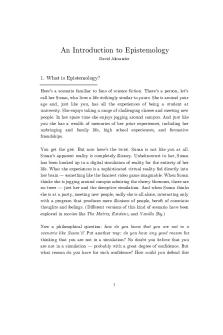8. Using Dehydration Reaction to Convert an Alcohol to an Alkene PDF

| Title | 8. Using Dehydration Reaction to Convert an Alcohol to an Alkene |
|---|---|
| Author | Tsz Lam |
| Course | Organic Chemistry Laboratory |
| Institution | Purdue University |
| Pages | 4 |
| File Size | 85.7 KB |
| File Type | |
| Total Downloads | 30 |
| Total Views | 153 |
Summary
lab report 8...
Description
Using Dehydration Reaction to Convert an Alcohol to an Alkene
_____________________________
_____________________________ Purpose: The goal of this experiment is to gain chemical knowledge of dehydration reactions through the creation of cyclohexene from cyclohexanol. Chemical Structures/Reactions:
Calculations:
Results
Isolated product: Cyclohexene Appearance: colorless, clear liquid
Mass of flask: 30.2956 grams Mass of flask & product: 31.0325 grams Amount of product obtained: .7369 grams Measured boiling point: 80-82°C Percent yield: 9.3% Bromine test results: When bromine was dropped into our distilled cyclohexene, the yellow bromine gas immediately turned clear. This is different from the bromine test results for cyclohexanol—the bromine gas did not change color and remained yellow.
IR spectrum data
Bond
Characteristic Functional Group/Bond Frequencies
Actual Frequency (cm-1), transmittance (%)
Cyclohexanol
O-H stretch C-O stretch -C-H stretch
3400-3350 1240-1080 2950-2880
3325.67, 80.84% 1064.80, 42.68% 2928.52, 2854.04 46.42%, 60.03%
Cyclohexene
=C-H stretch C=C stretch
3080-3010 1600-1680
3022.31, 85.75% 1652.69, 95.44%
Discussion Questions 1) Our percent yield was 9.3%, which is low. The low percent yield may have been caused by us not running the distillation long enough therefore not being able to get all the products that we wanted. 2)
3) The accepted boiling point range for cyclohexene is 83-85°C. The range that we found experimentally was 80-83°C. Our product’s boiling point range differed from the known boiling point range by ~ 1°C which indicates that our sample was not completely pure. This may have been caused by human error in distilling the solution.
4) The IR spectrum of the cyclohexanol and the cyclohexane is very similar to each other. However, since the cyclohexanol has an additional O-H group, there was an additional OH stretch peak at 3325.67 cm-1 that showed up in the IR spectrum. Also, in the cyclohexene, there is an alkene bond stretch peak at 1652.69 cm-1 that the cyclohexane IR spectrum does not have. 5) When bromine was dropped into our distilled cyclohexene, the yellow bromine gas immediately turned clear. This is different from the bromine test results for cyclohexanol —the bromine gas did not change color and remained yellow. These results suggest that our distilled product had more cyclohexene present than impurities. Since the bromine turned clear once added to the product, it shows that there is an alkene in the product. Conclusion: From this experiment we obtained a 9.3% percentage yield of cyclohexene that appeared as a colorless clear liquid, had a boiling range of 80-82°C, and bromine that turned from yellow to clear when dropped into cyclohexene. The product’s IR spectrum had a =C-H- stretch at 30803010 and a C=C stretch at 1600-1680. Based on our experimental data from the bromine test, IR spectrum, and appearance, we believe that we obtained the expected outcome of the experiment which was to synthesize cyclohexene from cyclohexanol using a dehydration reaction. The boiling point range of our product differed from the actual boiling point range by ~1°C, which suggests that our product had some impurities. Some ways we can improve this experiment is to make sure to collect all possible products through distillation, make sure that the boiling point does not exceed 85 degrees Celsius, and make sure that the distillation setup is at the correct angle so that all the product that is being collected will be in the receiving flask....
Similar Free PDFs

Bromination of an Alkene
- 2 Pages

An introduction to Psychology
- 4 Pages

An introduction to sociolinguistics
- 451 Pages

Guide to Selecting an Attorney
- 2 Pages

Right to an Occupation Fee
- 1 Pages

1. An Introduction to Epistemology
- 10 Pages

1. An Introduction to Glaciers
- 6 Pages

How to Write an Exegesis
- 11 Pages
Popular Institutions
- Tinajero National High School - Annex
- Politeknik Caltex Riau
- Yokohama City University
- SGT University
- University of Al-Qadisiyah
- Divine Word College of Vigan
- Techniek College Rotterdam
- Universidade de Santiago
- Universiti Teknologi MARA Cawangan Johor Kampus Pasir Gudang
- Poltekkes Kemenkes Yogyakarta
- Baguio City National High School
- Colegio san marcos
- preparatoria uno
- Centro de Bachillerato Tecnológico Industrial y de Servicios No. 107
- Dalian Maritime University
- Quang Trung Secondary School
- Colegio Tecnológico en Informática
- Corporación Regional de Educación Superior
- Grupo CEDVA
- Dar Al Uloom University
- Centro de Estudios Preuniversitarios de la Universidad Nacional de Ingeniería
- 上智大学
- Aakash International School, Nuna Majara
- San Felipe Neri Catholic School
- Kang Chiao International School - New Taipei City
- Misamis Occidental National High School
- Institución Educativa Escuela Normal Juan Ladrilleros
- Kolehiyo ng Pantukan
- Batanes State College
- Instituto Continental
- Sekolah Menengah Kejuruan Kesehatan Kaltara (Tarakan)
- Colegio de La Inmaculada Concepcion - Cebu







